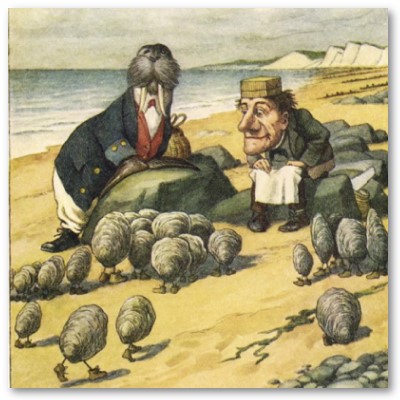
What's the matter with matter? According to physicists, all non-dark matter is the same basic stuff. As the Walrus might have said to the Carpenter, the same stuff that forms a cabbage forms a King. Sealing wax is made of the same stuff as string. Exactly the same stuff. Identical in every material respect.
Physicists believe that the stuff of matter is sub-atomic particles considered to be fundamental, ie elementary and indivisible. These fundamental particles---specifically, electrons and quarks---have no bits or parts or components, and cannot be divided or reduced into bits or parts or components. (Strangely enough, the particles are also waves, or rather, have a wave nature as well as a particle nature, but that is a whole other story, and a peculiar one at that.)
Venn diagram A (above) shows two sets: 1) the set of living things, and 2) the set of inanimate objects. In the background are all the members of the universal set---the set from which all members of all sets are drawn. Anything and everything that is made of electrons and quarks is a member of the universal set. (Strictly speaking this is a universal set of matter only; does not include non-material members, eg forces, eg force of gravity.) Diagram A says there are no living things that are inanimate objects, and no inanimate objects that are living things. There is no intersection between the two sets, no overlap. (Actually, there may be. Viruses are said to exist on the borderline of life. Artificial intelligence embodied in a robot would be another example.)
 A living thing, eg a walrus, is made of exactly, identically the same stuff---quarks and electrons---as any other living thing, eg a carpenter, is made of. Moreover, every living thing is made of the same stuff as every inanimate object, eg a rock, is made of. The only material difference between a walrus and a carpenter, or between a rock and a walrus, is in the way the stuff is arranged or structured. As an analogy: A cave can be carved (made, formed) out of the same basic stuff (rock/stone) as can be used to build an elegant and luxurious palace. Matter is made of molecules made of atoms made of sub-atomic particles. And at every step, the nature of the item is determined by the nature of the item in the preceding step/s.
A living thing, eg a walrus, is made of exactly, identically the same stuff---quarks and electrons---as any other living thing, eg a carpenter, is made of. Moreover, every living thing is made of the same stuff as every inanimate object, eg a rock, is made of. The only material difference between a walrus and a carpenter, or between a rock and a walrus, is in the way the stuff is arranged or structured. As an analogy: A cave can be carved (made, formed) out of the same basic stuff (rock/stone) as can be used to build an elegant and luxurious palace. Matter is made of molecules made of atoms made of sub-atomic particles. And at every step, the nature of the item is determined by the nature of the item in the preceding step/s.
So what? Why does any of this matter? It matters in terms of explaining how the simple few produce the complex many. How is all the complexity and richness of the innumerable differences between a cabbage and a king wholly explained or produced by something as relatively simple as molecular structure? Or by a handful of basic qualities such as electromagnetic charge, spin and number of electrons in the outer shell of the atom. But more of this in later posts. Bear with me. It hots up, I swear. You do want to know the nature of reality, don't you?
PS If you're wondering about this post's title, as the late great J Hendrix explains, "all castles made of sand, slip into the sea, eventually"; except in this case not into the Briny Beach of Carroll's foamy Poem, but into the very quantum foam itself!







COMMENTS? Come on... gimme your best shot!